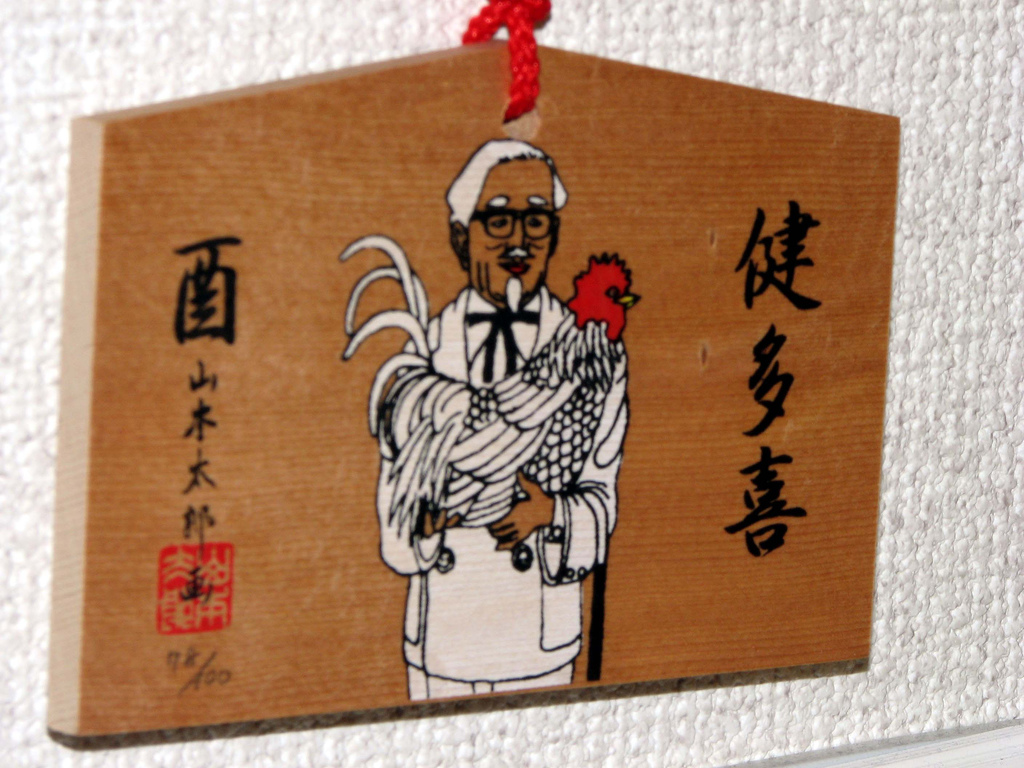
A Shinto prayer tablet featuring Colonel Sanders of KFC. Photo © Chris Gladis, licensed Creative Commons Attribution No-Derivatives.
When you first come to Japan, you may observe things that look like cultural contradictions, a clash of East and West. For example, while waiting on a train platform, you might see a woman in a traditional kimono using a smart phone, two businesspeople bowing and shaking hands simultaneously, or a blonde Japanese with a mohawk. Newcomers to Japan often perceive such phenomena as contradictions, because they’ve never imagined these particular cultural elements in comfortable juxtaposition. In my experience observing two cultures, it’s no more incongruous for a woman in a kimono to use a keitai (cell phone) than for a Western man in a tuxedo to do so. Though we may regard modern accoutrements as belonging to the West, they are just as intrinsic a part of Japanese culture and daily life.After all, Japan has been blending foreign elements into its culture for several thousand years—Buddhist thought and arts from India, China, and Korea; Christianity from the Middle East via Europe; literature and a writing system from China and Europe; medicine from Germany; parliamentary government from Europe; modern business and manufacturing practices from the United States; public school education from Europe and the United States; school uniforms from Prussia; football and rugby from Europe; and baseball and, more recently, hamburgers, Starbucks, and KFC from the United States.
Below is a table with some quick comparative facts between the Japan and the United States:
Korean 0.5 percent
Chinese 0.4 percent
Other (Ainu, Brazilian, Filipino, etc.) 0.7 percent Anglo non-Hispanic 63 percent
Hispanic or Latino 17 percent
African-American 13 percent
Asian 4.2 percent
Alaska native 1.5 percent
Hawaiian, Pacific Islander 0.3 percent
Other 4 percent Fiscal Year April 1 to March 31/td> October 1 to September 31 Gross Domestic Product (GDP) $5.855 trillion $15.06 trillion GDP per Capita $42,800 $47,600 Government Type Parliamentary government with constitutional monarch Constitution-based federal republic Gun-Related Deaths/Year 94 31,347* Infant Mortality 2.2 deaths/1,000 live births 5.98 deaths/1,000 live births Landmass 377,835 square kilometers 9.6 million square kilometers Life Expectancy 84 years 78.5 years Literacy 99 percent 97 percent Natural Resources Negligible minerals, fish Coal, copper, lead, molybdenum, phosphates, uranium, bauxite, gold, iron, mercury, nickel, etc. Obesity 3.1 percent 33.9 percent Oil Consumption 4.452 million barrels/day 19.15 million barrels/day Population 127 million 313 million Religion Shinto 84 percent
Buddhist 71 percent
Other 15 percent (1 percent Christian) Protestant 52 percent
Catholic 24 percent
Jewish 1.7 percent
Muslim 1 percent
Other 19 percent
School Year
April to March
September to June
Unemployment Rate
4.6 percent
8.3 percent
Source: The World Fact Book
*CDC National Center for Health Statistics mortality report online, 2010
Excerpted from the Third Edition of Moon Living Abroad in Japan.